-
Rotovap
Much of the motivation here was being able to use vermouth or some other oddball mixers we can't produce ourselves, in our tasting room, which isn't permitted here.
Some may look at de-alc'ing Antica as heresy, but it 100% works.
Rotovap@grim said: Did a few bottles of bourbon for "dry January" for friends. Not necessarily zero alc, as you need to distill off a 'heads' fraction first, and add that back in after removing the bulk of the ethanol.
The time I tried this, the de-alc remainder was very cloudy. How did you turn that into something that looked remotely clear like bourbon? Were the heads enough to clear it up a little? Adding water to bring back to volume didn't help.
@grim said: You absolutely can not do this at atmospheric, the higher temperature will absolutely destroy numerous flavor compounds, you need to do this under deep vacuum at very low temperatures, and have a chiller that can support the temp ranges you need (we run around -10c or -20c depending on the time of year).
That's probably an argument for keeping bottles out of the sunlight too.
RotovapWe de-alc finished spirits and wines with the rotovap all the time.
Did a few bottles of bourbon for "dry January" for friends. Not necessarily zero alc, as you need to distill off a 'heads' fraction first, and add that back in after removing the bulk of the ethanol.
You absolutely can not do this at atmospheric, the higher temperature will absolutely destroy numerous flavor compounds, you need to do this under deep vacuum at very low temperatures, and have a chiller that can support the temp ranges you need (we run around -10c or -20c depending on the time of year).
When doing these kinds of temp sensitive evaporations, we run the water bath at a few degrees over ambient so we have some way to control heat input.
DonMateo's Distillery ShedThanks mate. Here are a few more fotos. The first is the highly specialised front end loader as still removal crane thingy, the next is yours truly to give an idea of size of this thing and the final is a welding fotos for the equipment guys, which is most of us. The guy with the beer gut hooking up the lifting sling is Raul my gardener. I was going to take a gardners crack foto but that would have been a step too far.
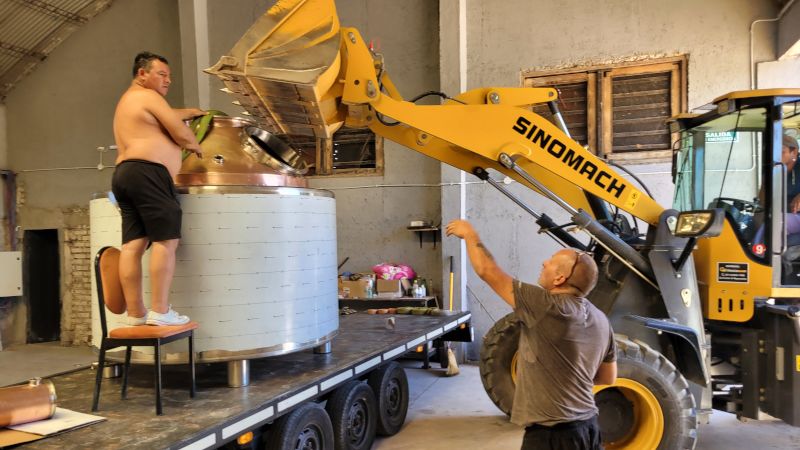
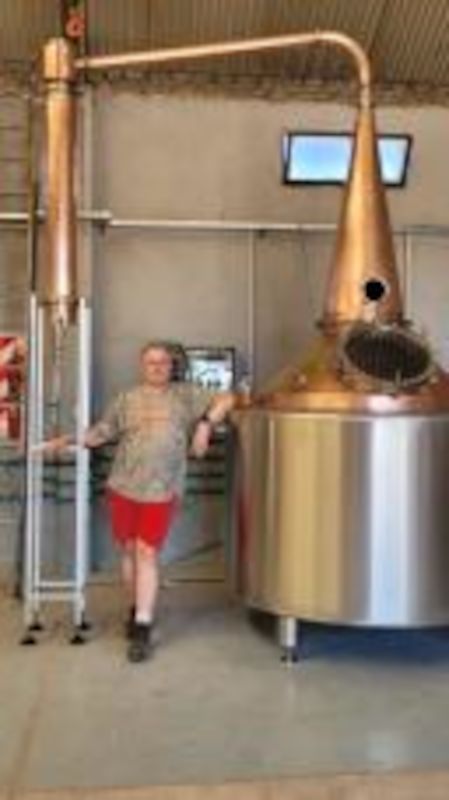
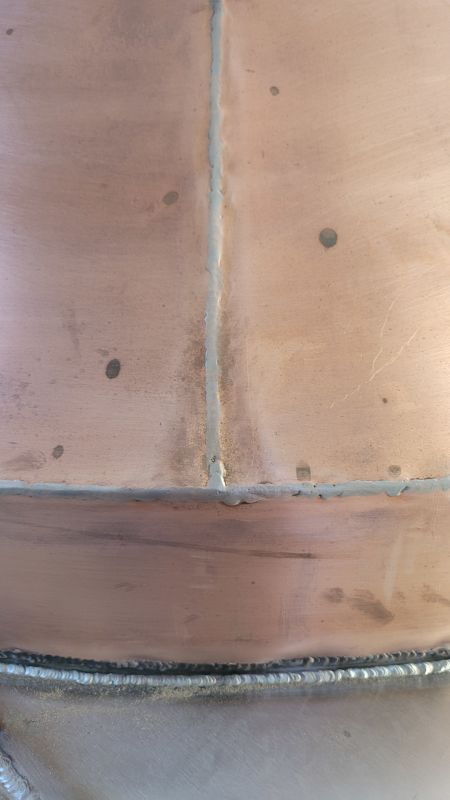 GNS Continuous Still?
GNS Continuous Still?Just looked at some of those older threads, those guys were talking about 408 watts per gallon of feed per hour, not per minute, which I think explains it. For 2 gallons a minute, that's 2 * 60 * 408 = 49kw. Now we're cooking.
I have a tube in shell boiler that came out of a Millipore steam distillation purifier skid unit that I was experimenting with for building one of these. It's built for steam feed, and to boil 100% of the feed in one pass.
I'm not joking when I tell you that thing can easily consume every single BTU of our main boiler to be able to boil off a few gallons a minute (single digits). We're talking way more than 150kw, but there was no heat recovery in my testing.
One of my favorite tests was trying to build a continuous gin still off the vapor feed. Take a feed from a barrel of GNS and a barrel of water. Boil them off at the desired ABV. Push that vapor through a set of two baskets (with a valve to direct the vapor feed). Turn that baby on and just keep changing baskets until your swimming pool is full of gin.
GNS Continuous Still?That larger one is a behemoth at 5-10 gpm
GNS Continuous Still?Electric element would work, but you would need additional level sensors to prevent the element from running dry, and if you really built this thing using all classified (xp) electrics, it would be expensive. Your feed rate will be entirely determined based on how fast you can vaporize 100% of your feed.
Unfortunately, you absolutely can not proof down with this approach. Your product will be taken off as exactly the same proof as your input. If you proof to 40%, your distillate can not be considered vodka or neutral spirits, it's going to come off at 40%.
Would also require significantly more energy to heat and cool the greater volume.
Work with extracts & canning issuesCheck out some of the folded/deterpinated citrus oils in lieu of straight extracts (or just rotovap your own). They are largely colorless and much more stable.
Short of it is, they are lower in limonene and other monoterpenes than traditional extracts, this allows more of the citrus varietal character to shine. Straight extracts are really hard to discriminate (citrus, citrus, citrus, citrus). With the 5x-10x, one quick smell and you can tell exactly.
This doesn't replace the 'juice' consideration in a cocktail (some of the terpenes are required), but they can be used in conjunction to add some amazing aroma and top-note that really feel lighter, fresher, natural, and higher quality. Also worth noting that folded oils are more stable and more soluble, as it's usually the terpenes that cause solubility issues (but concentrations are significantly higher, so you can not use folded oils as a 1:1 substitute).
There are also significant regional considerations for the flavor and aroma quality (lime is famous for this).
Work with extracts & canning issuesOne wonders from a cost perspective, for viability of canning a 100ml can size.
I saw this can filler (didn't include seaming) that looked quite interesting at Euro 10,950.-
Work with extracts & canning issuesThese are the little guys: 100mL Can @ Very Good Mfg
MERRY XMAS 2023Ho Fuckin' ho
 3 Chamber Still
3 Chamber Still@Smaug said: On the drawing here (2000L chambers), the preheater coil has 62.8 sq. ft. (5.8 sq. meters) worth of surface area if my math is correct.
The piping on the left-hand side is the vent that allows for smooth liquid transfer.
We will incorporate automatic valves and and PLC control to handle all of the liquid transfer duties.
Hello @Smaug,
I hope you're doing well. I've been following your discussions about the distillation setup and find your insights extremely valuable. I have a couple of questions regarding your setup, particularly about the coil and its heat transfer capabilities.
I understand the importance of not having all the ethanol condense inside the pipe, aiming for a condensation rate of about 10-15%. This is why I'm curious about the surface area you've estimated for your coil. Could you kindly share what size of pipe you're using for the coil? Is it a 2" inch pipe? Given the surface area, it seems like the coil in your condenser would be around 1387 meters of pipe. How did you arrive at this specific size?
Also, in my design, I haven't incorporated pipes on the side for moving the wash. Instead, I've opted for a conic bottom with a 4-inch knife valve for control, positioned at the side. I'd love to hear your thoughts on this approach.
Thank you for taking the time to read my query. Any insights or advice you could offer would be greatly appreciated.
3 Chamber Still@DonMateo said: Thats what I thought. If I remember my hydraulics design classes from construction school. Its a vent stack with valves for each chamber. You will have to open them all prior to draining from one chamber to the next and they will be the last thing you close before turn the power on.
100%
[USA/MO] Sale: 8" Bubble Cap 16 Plate Distillation ColumnColumn was used for GNS (100% wheat) production - equipment is now idle and I'm motivated to sell it.
Purchased new in 2016 and was used for 4 years.- SD ProCap Plate Assembly
- All clamps, gaskets, flow directors, etc
- 8" Column Base
- 8" Stainless Steel Dephlegmator
- Reflux Float Switch
- Taco Reflux Pump
- Reflux Pump Controller
8" - 16 plate reflux distillation column for sale: $11,000
Located in Kansas City, MO, USA. Buyer coordinates shipping.Email me for more information: derrick@liftedspiritskc.com
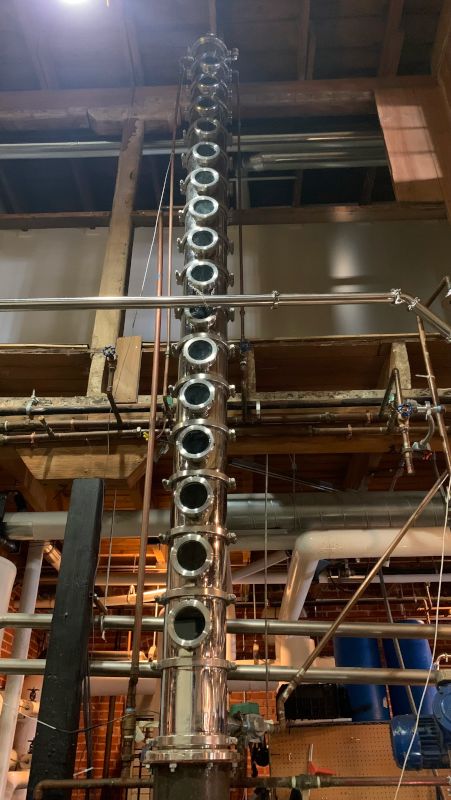
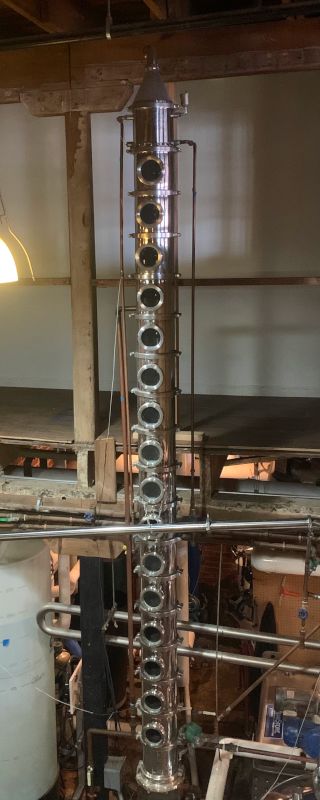 Pressure relief valve three chamber still
Pressure relief valve three chamber stillHey @Bolverk you are taking about that 2" stainless steel pipe (red selection) connected to the top of each chamber with the valves or you referring to that probably 1" pipe coming from the bottom chamber only at the back (blue selection), because if its the blue he is just using for bottom chamber as I was thinking because is were you are injecting live steam.
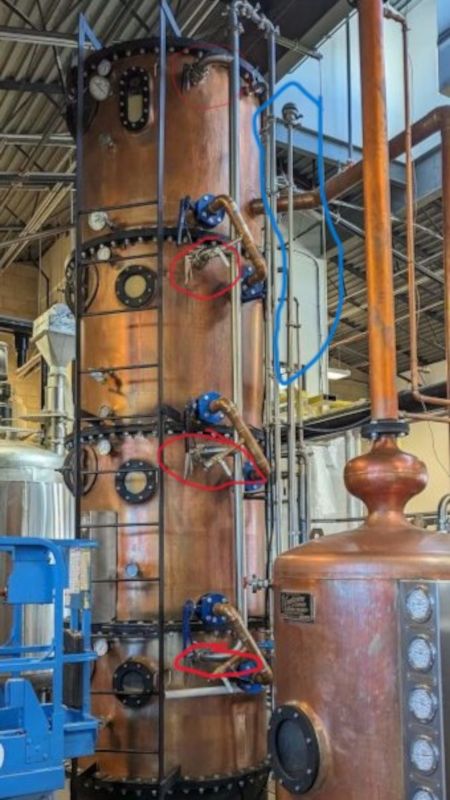 Three-Chamber Still
Three-Chamber StillHey mate. Everytime ibdid the calculations incame up with 1.06 bar and a temp of 106 deg thats with a liquid column height of 600mm. The main source of doubt that i have is wash does not behave like water due to the ethanol content. So the temperature effect is probably higher. As well i live at 900masl. So my boiling point for water and wash is 3 degrees lower. There is only one way to find out. Build it and they will come.
Three-Chamber StillHey everyone, I want to thank you all for sharing your opinions with me. Currently, I am working on modelling the process using Aspen Plus and HYSYS. However, since it's not a continuous process, it's taking me more time to work on it as a semicontinuous process. @DonMateo , you are right that I could get ferulic acid from rye, which is a phenolic acid that gives more flavour to the whisky. However, we are building a continuous still and three-chamber still exclusively for whisky production. so I'm just trying to get a simulation for chamber still which give me enough data about process. 105 celsius for bottom chamber
What does the temperature of the wash after be preheated in the top chamber?The old 1910 IRS documentation says a heads cut is made (the drawing is a little hard to read, i can't make out the temps shown). My assumption is that they were preheating the beer charge to close to vaporizing (150f +/-) then that's when they drop the charge, heat it back up in the chamber below and make the heads, middle runs, and tails cuts.
But I think like Smaug is saying, thats probably a lot to do what the operator is trying to produce.
Three-Chamber Still@Bolverk said: My understanding and I'm 100% prepared to be wrong about this...
If you're using it as a finishing still the doubler/thumper have got to count for more somewhere around 1 plate, otherwise how do we get to barreling strength in a single pass?
Driving slower.
Three-Chamber StillMy understanding and I'm 100% prepared to be wrong about this...
If you're using it as a finishing still the doubler/thumper have got to count for more somewhere around 1 plate, otherwise how do we get to barreling strength in a single pass?



